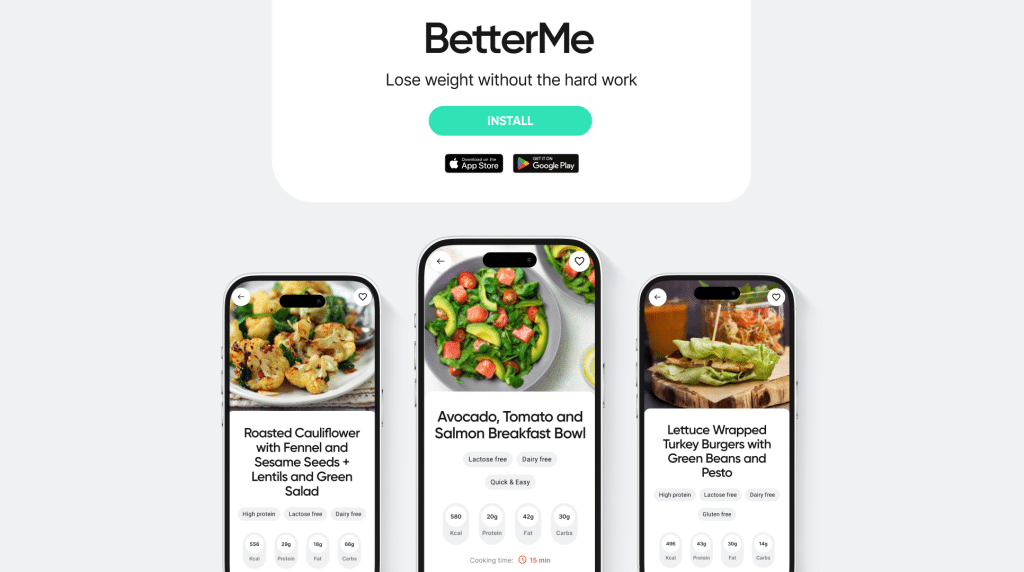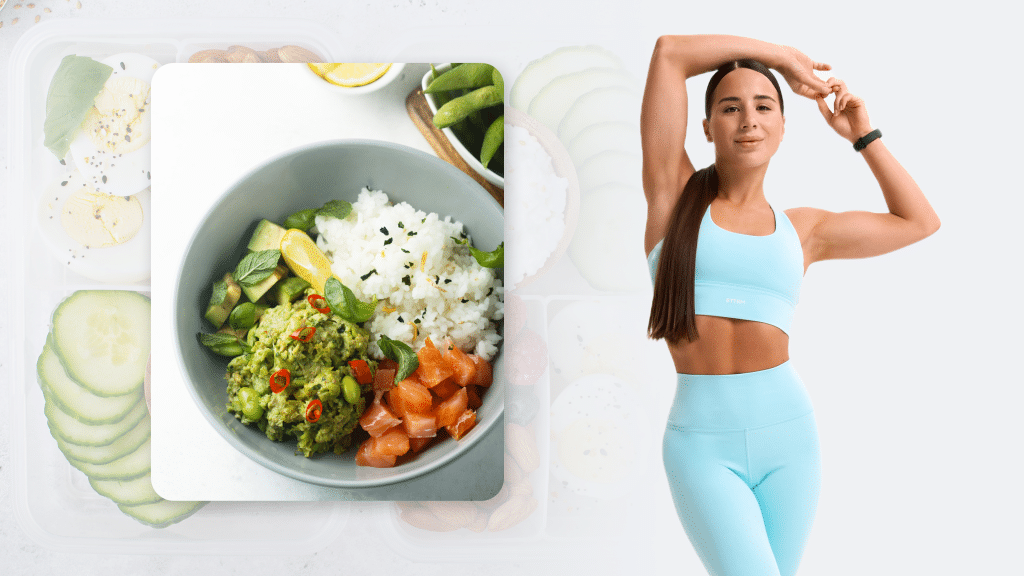You’re trying to lose some fat, but everywhere you look for helpful information, you find conflicting views on counting your macros. You can’t seem to figure out the proper macronutrient ratio that’ll help you lose weight.
The truth is there’s no ironclad law when it comes to planning your macros. No macro ratio can give you the results you want if you’re eating too many calories or too few. However, your macro ratios are still an important consideration, so here’s everything you need to know about how to count macros.
What Should My Macros Be?
Your “macros” are your caloric intake from macronutrients (protein, carbs, and fat). The balance between these macros will be influenced by whether you’re eating for cutting or bulking – gaining muscle mass or losing fat. In most cases, these foods should be eaten in a ratio of 45-65% carbs, 10-35% proteins, and 20-35% fats (15).
However, there’s no one-size-fits-all macro split for cutting. Your body type, metabolism, and physical activity level will all impact your ideal percentages at a given time. You should bear in mind that you won’t use one macronutrient ratio forever – it may change if and when your body weight or body fat fluctuates or if you encounter any plateaus.
Macro-Morphing
According to ISSA (a body that certifies personal trainers) guidelines for cutting, this is the protocol you may want to follow (4):
- A calorie deficit of 10-20% from your total daily energy expenditure (TDEE)
- Protein intake of 1 g/lb of lean body weight.
Just as your body is different from someone else’s, so are your macro requirements. Before you start settling on a macro split regimen, it’s important to understand which macronutrient ratio may work best for your body type. Based on ISSA recommendations, there are 3 main sets of ratios based on body types:
Ectomorph
If you’re an ectomorph, you have a lean, hard-gaining body type. You’re naturally thin with a high metabolic rate and have a high tolerance for carbs. A good starting macronutrient ratio for you may be around 25% protein, 55% carbs, and 20% fat.
Read More: Ectomorph Diet: A Foolproof Way To Outwit Your Genes
Mesomorph
If you’re a mesomorph, you have an athletic, well-toned physique that gains muscle easily on a diet that is rich in protein with moderate carbs. You likely have a moderate metabolic rate. A good macro split for you may be around 30% protein, 40% carb, 30% fat
Endomorph
If you’re an endomorph, you have a round figure. You may have a low tolerance for carbohydrates and a slower metabolic rate. An ideal macro split might be around 35% protein, 25% carbs, and 40% fat.
These categorizations are broad and are not based on scientific research, so you should take them with a pinch of salt. It may take some trial and error to figure out what works best for you.
How to Calculate Macros for Cutting?
The main goal when doing a recomp (cutting) diet is to lose body fat while maintaining as much muscle as possible (2). Most people lift weights regularly as they want to avoid going into a catabolic state where their muscle gets eaten up for energy. Your goals are to lose fat, preserve your muscle, and eat a balanced diet so you don’t get sick from having too little carbs or protein.
You’ll notice that most macro split recommendations are called “starting macros”. This is because the best way to determine your ideal macro split for cutting while retaining muscle is by trial and error over several weeks. You’ll need to keep adjusting the ratio as you go.
Start by finding your ideal macro ratio using a macro calculator that can be found on several fitness sites. All you need to do is enter some basic information and it will tell you exactly what percentage of your calories should come from protein, fat, and carbohydrates.
You can then start your trial and error by following these steps:
- Measure your weight once per week.
- Track your daily macro intake.
- After at least 2 weeks, you should start to notice results.
- If you lose fat but maintain muscle mass over several weeks, this is a sign of good macro-management. In that case, try to learn what happened and how you can improve your ratios for future meals and workouts.
- If you’re not losing enough fat, you should consider reducing your calories or increasing your exercise until results are visible.
- Maintaining the same workout routine without seeing improvement could also be due to poor recovery from workouts (recovery is known as hypertrophy) so make sure your sleep, diet, and supplementation are adequate before changing your macros (12).
- Give it time and don’t change ratios more than once every 2 weeks.
- Once you get in touch with the best ratio, you can consider increasing your calories by 5% as it’s actually quite difficult to maintain a caloric deficit over long periods of time.
This increase in calories doesn’t mean you can eat anything you want as long as it fits your macros. You still need to follow the basic rules of healthy eating: avoid too much junk food, added sugar, and ultra-processed foods as much as possible (8).
Find more information in our Counting Macros for Weight Loss article.
Counting Calories vs Counting Macros
When it comes to losing fat, how much you eat matters more than the amounts of carbs, fat, and protein in your food. Several studies have shown that any reduced-calorie (low-carb, low-fat, etc) diet can cause similar amounts of weight loss in the long term (5).
The key to fat loss is a calorie deficit. Without this, no macro ratio will work.
However, not all calories are the same. Calories from different food sources have a different impact on satiety, metabolic rate, and hormonal responses (13). This is why you need to consider your macros.
Think of it this way: to get 100 calories from broccoli, you’ll need to eat four cups (340 grams) of it. At the same time, to get 100 calories from doughnuts, you’ll only eat half of a medium-sized glazed doughnut.
If you manage to finish four cups of broccoli in one sitting, you’ll be very full from all the fiber. You will also have gotten all the nutrients contained in these vegetables. However, to get full from doughnuts you’ll need to eat more than a half. Even worse, you’ll be filling up on refined carbs and fats.
So although calories determine weight loss, they differ in how they affect your health and ability to lose weight. That is why simply counting calories isn’t enough – you need to go the extra mile to choose healthy sources of these calories, And this boils down to finding the best macro split for your body type.
Meal Prepping to Hit Your Macros
Knowing your macros is only half the battle, and you also need to eat a diet that helps you hit them. Meal prepping for a macro-based diet isn’t easy — it takes a fair amount of strategy and commitment.
That being said, if you’re serious about reaching your goals and getting consistent results, meal prepping is what will separate the protein shake crowd from the shredded one.
Meal prepping provides a number of benefits that help you reach your goals and lose weight (11). You’ll have no excuses to eat junk food as you’ve stocked up on healthy meals and snacks. More importantly, you’ll have less stress by planning meals in advance, which makes healthy eating less frustrating and easier to stick to in the long term.
Here are some of the best strategies for hitting your macros with ease:
Get Your Portions Right
Meal prepping on a macro diet can make keeping your portion control in check and calorie control even easier. Consider buying a food scale or use a food tracking app to be as precise as possible and learn the exact portion sizes that match your individual needs.
It should be noted that your portions can change based on your activity (10). You can adjust carb and protein portions around your workouts, eating more food when you’re more active and lighter measl on rest days or when you’re not moving around as much.
Here are some portion control tips for your meals:
Pack Each Meal with Vegetables
Choose vegetables you enjoy eating. They help minimize hunger pangs and keep you feeling fuller longer so you don’t go overboard on the rest of your food (3). Leafy greens, cruciferous vegetables, and other varieties can be particularly beneficial and easy to prepare in advance.
Choose Lean Proteins
Include foods with lean protein in each meal. Aim for approximately 30 grams of healthy protein per meal (14). Keep it as lean as possible with the exception of fish; trim the fat off your meats or remove skin when preparing chicken breasts. Turkey, fish, eggs, beans, legumes, dairy (in limited amounts), nuts, and seeds are all excellent sources to use throughout the day.
Use Whole Grains
Whole grains are a great addition to each meal. They’re naturally rich in fiber, which will help you feel full, and have been shown to help stabilize blood sugar levels after eating (6). Stick with whole grains such as oatmeal, quinoa, brown rice, or whole-grain pasta.
The Fats You Add to Your Meals Should Be Healthy Ones
Healthy fats can include foods such as avocado, olive oil, and nuts (1). Include these into your meals for extra satiety and nutrition (particularly if you’re using them as snacks between meals). Fish oils, flaxseed oil, and walnuts are all great options for boosting Omega 3’s in your diet too.
Minimize Heavy Sauces and High-Sugar Dressings
Try to keep your meal prep as simple as possible by minimizing the amount of high-sugar dressings you use, even in sauces. You can use a variety of herbs and spices. If you’re looking for warmth and sweetness, try cinnamon, vanilla extract, or cocoa powder without adding sugar.
If you wish to free yourself from all the extra pounds that have been weighing you down for way too long, start using the BetterMe app and overhaul your entire life!
Consider Volume Eating
Your portions should be just enough so you’re satiated. Too little will leave you starving, and too much will result in overeating. One way to get full without eating too many calories is by volume eating. Volume eating is eating large portions of low-calorie foods such as vegetables.
Split Nuts into Single Servings
Nuts contain a lot of calories, but don’t let that scare you off, because they’re also rich in protein, fiber, and various vitamins and minerals (7). Just remember not to overdo it! As the serving size is pretty small, split them into individual servings using sandwich bags. This will allow you to still enjoy each snack portion without eating too much.
When preparing single-serve containers, add some fresh berries to give them a little extra flavor. This is delicious and also satisfies any cravings you may have for something sweet.
Choose a Method that Works for You
Meal prepping doesn’t need to mean spending hours in the kitchen every day planning meals (although if you want to do it this way then go for it). You may find that batch cooking on weekends works best for you (9). Prepare one “big” meal at the start of each weekend and then split it into individual containers for throughout the week, e.g. chicken burgers with salad and sweet potato fries, so you can then have one meal that’s ready to go.
Read More: 21-Day Carb Cycling: Boost Your Fat Loss With This Weekly Meal Plan
Stock up on Staple Foods When They’re on Sale
A macro-based diet can be expensive to stick to when shopping at regular grocery stores, so search for sale items on things that are commonly used in your recipes and stock up when they’re available.
Items such as chicken, peanut butter, ground beef, and cheese freeze well when they’re packaged properly in air-sealed containers or bags. Pick a few staple flavors of your favorite protein sources and then mix them up by cooking different sauces with them (e.g. BBQ sauce mixed with ground beef) so you have less repetition with what you’re eating throughout the week.
What is the Best Macro Ratio for Cutting?
The best macro ratio for cutting is one that’s aligned with your specific goals and body type. Generally, a standard macro ratio for cutting is approximately 40% protein, 30% carbohydrates, and 30% fat. However, it can vary depending on individual needs and preferences.
It’s important to understand that the best macro ratio for cutting isn’t a one-size-fits-all approach. Each person’s body composition, activity level, and overall health should be taken into consideration when determining the optimal macro ratio for cutting.
-
Body Composition
The amount of muscle mass and body fat an individual has can significantly impact their macronutrient needs. Those with higher levels of muscle mass may require a higher protein intake to maintain their muscle mass while cutting, while those with a higher percentage of body fat may benefit from a lower carbohydrate or fat intake.
In our previous blog post on the 7-day meal plan for muscle gain, we discussed high-protein meal plans for muscle gain.
-
Activity Level
The more physically active an individual is, the more carbohydrates they may need to fuel their workouts and support muscle recovery. At the same time, someone who leads a sedentary lifestyle may not require as many carbohydrates and could benefit from a higher protein and fat intake for satiety and overall health.
-
Personal Preferences
Some individuals may feel better with a higher protein intake, while others may do well with a higher fat intake. Experimenting with different macro ratios and listening to your body’s response can help you determine the best ratio for you.
While it’s tempting to focus solely on one macronutrient when cutting, it’s important to remember that all three macronutrients play important roles in our overall health and well-being.
Restricting any one nutrient too much can lead to deficiencies and imbalances in the body. A balanced macro ratio supports weight loss and muscle preservation during cutting and also provides the necessary nutrients for optimal health.
FAQs
Is 40-30-30 a good macro split?
A 40-30-30 macro split, also known as the Zone Diet, involves consuming 40% of calories from carbohydrates, 30% from protein, and 30% from fats. This ratio is claimed to balance blood sugar levels, control hunger, and optimize energy.
While this split can work well for some individuals, the optimal macro split varies based on factors such as activity level, goals, and personal preferences. It’s important to listen to your body and adjust your macros accordingly. Consider consulting a dietitian or nutritionist to determine the best macro split for your specific needs.
How do I set macros for a cut?
To set macros for a cut, you should follow these steps:
- Determine your daily calorie needs: Use an online calculator or consult a professional to determine your maintenance calories.
- Create a calorie deficit: To lose weight, you need to consume fewer calories than you burn. You should aim for a deficit of 500-1,000 calories per day to lose 1-2 pounds per week.
- Set protein intake: Protein is essential for preserving muscle mass during cutting. Aim for 0.8-1 gram of protein per pound of body weight.
- Allocate remaining calories towards carbs and fats: The amount of carbs and fats you consume will depend on personal preferences and needs. You may start with a 45-30 ratio for carbs and fats and adjust as needed.
Remember that the best macro ratio for cutting is one that supports both physical and mental health while helping you reach your desired body composition.
What is the macro split for 2,000 calories?
The macro split for 2,000 calories can vary depending on individual needs and goals. However, a general recommendation is to consume 45-65% of calories from carbohydrates, 10-35% from protein, and 20-35% from fats.
However, it’s important to note that these are wide ranges as individual needs will vary. Some individuals may feel better with a higher or lower intake of certain macronutrients. It’s important to listen to your body and make adjustments accordingly to find the best macro split for you
The Bottom Line
When it comes to the best macro split for cutting bodybuilding, there’s no single answer because every person has different nutritional requirements based on their goals (lose fat fast vs slow and steady), genetics, and activity level. However, once you find a macro split that works, you should commit to it as much as possible. By tracking your food intake closely, measuring results, and changing ratios if necessary, there’s no reason why you can’t have success on your quest for a leaner body.
DISCLAIMER:
This article is intended for general informational purposes only and does not serve to address individual circumstances. It is not a substitute for professional advice or help and should not be relied on for making any kind of decision-making. Any action taken as a direct or indirect result of the information in this article is entirely at your own risk and is your sole responsibility.
BetterMe, its content staff, and its medical advisors accept no responsibility for inaccuracies, errors, misstatements, inconsistencies, or omissions and specifically disclaim any liability, loss or risk, personal, professional or otherwise, which may be incurred as a consequence, directly or indirectly, of the use and/or application of any content.
You should always seek the advice of your physician or other qualified health provider with any questions you may have regarding a medical condition or your specific situation. Never disregard professional medical advice or delay seeking it because of BetterMe content. If you suspect or think you may have a medical emergency, call your doctor.
SOURCES:
- A healthy approach to dietary fats: understanding the science and taking action to reduce consumer confusion (2017, ncbi.nlm.nih.gov)
- Body Recomposition: Can Trained Individuals Build Muscle and Lose Fat at the Same Time? (2020, journals.lww.com)
- Changes in Intake of Fruits and Vegetables and Weight Change in United States Men and Women Followed for Up to 24 Years: Analysis from Three Prospective Cohort Studies (2015, journals.plos.org)
- Counting Macros: A Reliable Way To Lose Weight? (n.d., issaonline.com)
- Effects of low-carbohydrate vs low-fat diets on weight loss and cardiovascular risk factors: a meta-analysis of randomized controlled trials (2006, pubmed.ncbi.nlm.nih.gov)
- Health Benefits of Dietary Whole Grains: An Umbrella Review of Meta-analyses (2016, ncbi.nlm.nih.gov)
- Health Benefits of Nut Consumption (2010, ncbi.nlm.nih.gov)
- Healthy diet (who.int) (2020, who.int)
- Home Meal Preparation: A Powerful Medical Intervention (2020, ncbi.nlm.nih.gov)
- Just Enough for You: About Food Portions | NIDDK (2016, niddk.nih.gov)
- Meal planning is associated with food variety, diet quality and body weight status in a large sample of French adults (2017, ncbi.nlm.nih.gov)
- Recovery from Exercise: Skeletal muscle and resistance exercise training; the role of protein synthesis in recovery and remodeling (2016, ncbi.nlm.nih.gov)
- The global obesity pandemic: shaped by global drivers and local environments (2011, pubmed.ncbi.nlm.nih.gov)
- The role of protein in weight loss and maintenance (2015, pubmed.ncbi.nlm.nih.gov)
- Utilizing Dietary Nutrient Ratios in Nutritional Research: Expanding the Concept of Nutrient Ratios to Macronutrients (209, ncbi.nlm.nih.gov)















